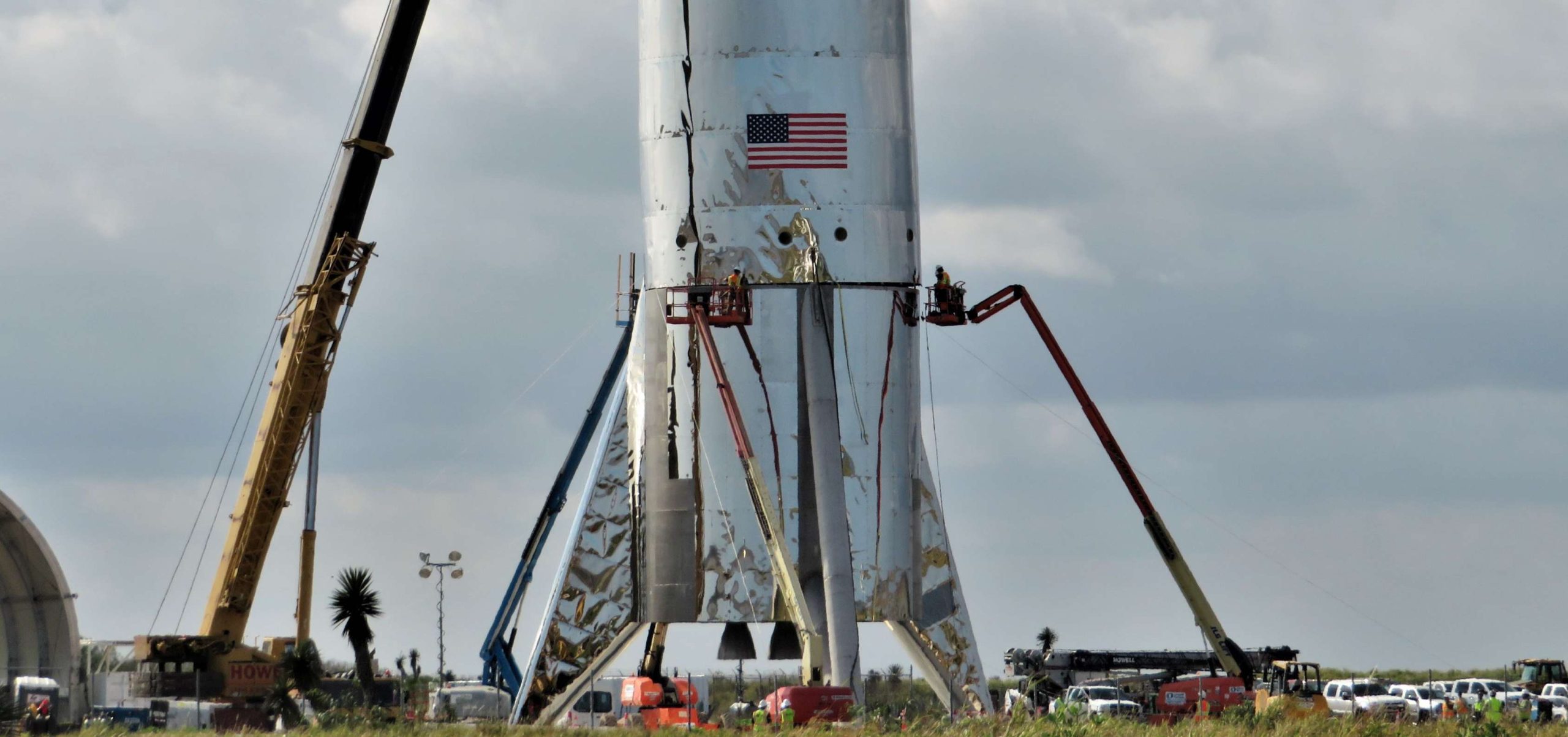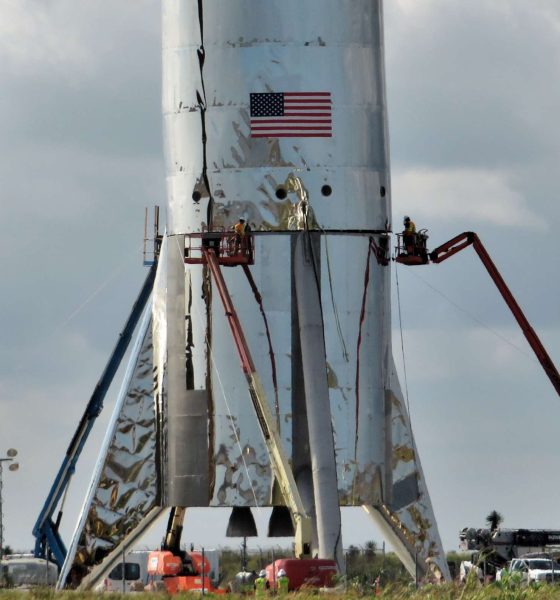

SpaceX
SpaceX’s Starship reaches new heights as Elon Musk teases Q1 2019 hop tests
In a burst of activity that should probably be expected at this point but still feels like a complete surprise, SpaceX technicians took a major step towards completing the first Starship hopper prototype by combining the last two remaining sections (aft and nose) scarcely six weeks after assembly began.
SpaceX CEO Elon Musk also took to Twitter late last week to offer additional details and post what appears to be the first official render of Starship’s hopper prototype, which is now closer than ever before to looking like the real deal thanks to the incredible drive of the company’s southernmost employees. With the massive rocket’s rough aeroshell and structure now more or less finalized, Musk’s targeted February/March hop test debut remains ambitious to the extreme but is now arguably far from impossible.
A quiet day as #SpaceX workers were having lunch and enjoying a well deserved break under the shadows of their creation. The wings/legs of the vehicle are getting an aesthetic touch up. 😍🚀 #Starshiphopper #ElonMusk #RGV pic.twitter.com/Y0zNGUNily
— Austin Barnard🚀 (@austinbarnard45) January 7, 2019
Where there was literally just a tent and some construction equipment barely eight weeks ago, SpaceX’s Boca Chica facilities now sport one of the most bizarre developments in recent aerospace history — a vast, ~30 ft (9m) diameter rocket being built en plein air out of tubes and sheets of common steel. At the current pace of work, 24 hours is often enough for wholly unexpected developments to appear, and this Starship hopper (Starhopper) is beginning to look more and more like its concept art as each day passes.
Aside from a few well-earned slow days last weekend, SpaceX technicians, engineers, and contractors have spent the last week or so shaping Starhopper into a form more reminiscent of the conceptual render (clearly hand-painted) Musk posted on Saturday. This primarily involved stacking a tall conical nose section atop a separate cylindrical body section, followed by gradually cladding both the aft section’s legs and barrel in sheets of stainless steel, presumably intended to improve both its aesthetic and aerodynamic characteristics.
Starship test vehicle under assembly will look similar to this illustration when finished. Operational Starships would obv have windows, etc. pic.twitter.com/D8AJ01mjyR
— Elon Musk (@elonmusk) January 5, 2019
SpaceX's Big Falcon Hopper/Starship Hopper at Boca Chica now has the three sections mated:#Shiny
Photo from NSF's BocaChicaGal:https://t.co/4RG5vZW4rN pic.twitter.com/Sd6W0Jepro
— NSF – NASASpaceflight.com (@NASASpaceflight) January 8, 2019
Notably, technicians have installed two out of three (?) aerodynamic shrouds at the top of each steel tube leg, bringing Starhopper’s appearance even closer to the smooth and polished aesthetic of its conceptual sibling.
Starhopper’s hopped-up hop test ETA
Musk later replied to a question related to Starhopper’s near-term schedule and stated that the nominal target for its first flight test was – almost unfathomably – four weeks away, although he admitted in the same response that that would probably translate into eight weeks due to “unforeseen issues”, placing the actual launch target sometime between February and March 2019. Just to reiterate, the site Starhopper is currently located on was quite literally empty – aside from the temporary tent – in late November 2018, barely more than six weeks ago.
Another great and beautiful day at #spacex today and progress is being made. I hope you all enjoy them, and have an amazing day.😃❤️🚀📸 pic.twitter.com/A9ukmdbgZI
— Austin Barnard🚀 (@austinbarnard45) January 5, 2019
To plan to go from a blank slate to actual integrated flight tests of a rocket – no matter how low-fidelity – that is 9m (~30 ft) in diameter, at least 40m (~130 ft) tall, could weigh as much as 500 tons (1.1M lbs), and may produce ~600 tons (~1.35M lb/f) of thrust at liftoff is extraordinarily ambitious even for SpaceX. At the end of the day, significant delays to Musk’s truly wild timeline are very likely, but it seems entirely possible at this point that Starhopper really could begin its first hop tests in the first half of 2019, kicking off a test program currently aiming for flights as high as 5 km (3.1 mi) and as long as 6 minutes.
A whole range of things will have to go perfectly right for a timeline as ambitious as this to be realized, including but not limited to successfully acceptance-testing three brand new and recently-redesigned Raptor engines, the completion of Starhopper’s unfamiliar structures, propellant tankage, plumbing, and avionics, and the completion of a rough launch and landing pad and integration facilities, if needed. Aside from those big ticket items, many dozens of other smaller but no less critical tasks will have to be completed with minimal to no unforeseen hurdles if hop tests are to begin just a few months from now.
And follow up from NSF member "bocachicagal"
Mating complete! 🙂 pic.twitter.com/LbR0PKENII
— NSF – NASASpaceflight.com (@NASASpaceflight) January 4, 2019
Regardless, SpaceX has pulled off miraculous tasks much like this in its past, and the possibility that the company’s brilliant, dedicated, and admittedly overworked employees will do so again should not be discounted.
For prompt updates, on-the-ground perspectives, and unique glimpses of SpaceX’s rocket recovery fleet check out our brand new LaunchPad and LandingZone newsletters!

Elon Musk
Elon Musk’s Biggest Revelations on AI, Robots, and the Future of Work from the Moonshots Podcast

Elon Musk’s appearance on the Moonshots with Peter Diamandis podcast was packed with bold predictions, candid admissions, and surprising tech insights. The nearly three-hour conversation covered everything from artificial intelligence to humanoid robots, geopolitics, and the future of work. Here are the top 10 most intriguing takeaways:
-
Aggressive AGI Timeline Predictions
Musk offered a detailed view on when artificial general intelligence (AGI) could emerge, suggesting it may arrive sooner than many expect, emphasizing both transformative potential and risks.
-
U.S. vs. China in the AI Race
He discussed the strategic competition between the United States and China over AI development, noting that geopolitical dynamics will shape how and who leads in the next decades.
-
Future of Job Markets
Musk touched on how AI and automation could reshape employment, predicting massive boosts in productivity alongside potential disruptions in traditional work structures.
-
Clean Energy Transition
A recurring theme was the role of clean energy in future economies, with Musk reiterating the importance of scaling sustainable power generation and storage.
-
Humanoid Robots Are Coming
On the podcast, Musk elaborated on Tesla’s work on humanoid robots, hinting at timelines and applications that go beyond factories to general-purpose assistance.
-
Tesla Roadster “Last Human-Driven Car”
Outside the core discussion topics, Musk teased features of the upcoming Tesla Roadster — calling it “the best of the last of the human-driven cars” and suggesting safety won’t be its main selling point.
-
The Role of AI in Clean Energy and Robotics
Linking AI to both energy optimization and robotics, Musk explained how smarter systems could accelerate decarbonization and task automation across industries.
-
U.S. Innovation Leadership
Musk argued that maintaining American leadership in key tech sectors like AI, space, and robotics should be a national priority, with thoughtful policy and investment.
-
Job Creation vs. Job Elimination
While acknowledging automation’s disruptive effects, he also outlined scenarios where new industries and opportunities could emerge, particularly in AI, space, and advanced manufacturing.
-
Long-Term Vision for Humanity
Throughout the conversation, Musk revisited his long-term philosophical views — including a belief in humanity’s responsibility to become a multi-planetary and technologically empowered species.
Whether you agree with Musk’s optimism or not, the podcast offers a window into the thinking of one of the most influential figures in tech today, in and why his visions continue to spark debate and inspiration.
Elon Musk
Starlink achieves major milestones in 2025 progress report
Starlink wrapped up 2025 with impressive growth, adding more than 4.6 million new active customers and expanding service to 35 additional countries, territories, and markets.

Starlink wrapped up 2025 with impressive growth, adding more than 4.6 million new active customers and expanding service to 35 additional countries, territories, and markets. The company also completed deployment of its first-generation Direct to Cell constellation, launching over 650 satellites in just 18 months to enable cellular connectivity.
SpaceX highlighted Starlink’s impressive 2025 progress in an extensive report.
Key achievements from Starlink’s 2025 Progress
Starlink connected over 4.6 million new customers with high-speed internet while bringing service to 35 more regions worldwide in 2025. Starlink is now connecting 9.2 million people worldwide. The service achieved this just weeks after hitting its 8 million customer milestone.
Starlink is now available in 155 markets, including areas that are unreachable by traditional ISPs. As per SpaceX, Starlink has also provided over 21 million airline passengers and 20 million cruise passengers with reliable high-speed internet connectivity during their travels.
Starlink Direct to Cell
Starlink’s Direct to Cell constellation, more than 650 satellites strong, has already connected over 12 million people at least once, marking a breakthrough in global mobile coverage.
Starlink Direct to Cell is currently rolled out to 22 countries and 6 continents, with over 6 million monthly customers. Starlink Direct to Cell also has 27 MNO partners to date.
“This year, SpaceX completed deployment of the first generation of the Starlink Direct to Cell constellation, with more than 650 satellites launched to low-Earth orbit in just 18 months. Starlink Direct to Cell has connected more than 12 million people, and counting, at least once, providing life-saving connectivity when people need it most,” SpaceX wrote.
Elon Musk
Starlink passes 9 million active customers just weeks after hitting 8 million
The milestone highlights the accelerating growth of Starlink, which has now been adding over 20,000 new users per day.

SpaceX’s Starlink satellite internet service has continued its rapid global expansion, surpassing 9 million active customers just weeks after crossing the 8 million mark.
The milestone highlights the accelerating growth of Starlink, which has now been adding over 20,000 new users per day.
9 million customers
In a post on X, SpaceX stated that Starlink now serves over 9 million active users across 155 countries, territories, and markets. The company reached 8 million customers in early November, meaning it added roughly 1 million subscribers in under seven weeks, or about 21,275 new users on average per day.
“Starlink is connecting more than 9M active customers with high-speed internet across 155 countries, territories, and many other markets,” Starlink wrote in a post on its official X account. SpaceX President Gwynne Shotwell also celebrated the milestone on X. “A huge thank you to all of our customers and congrats to the Starlink team for such an incredible product,” she wrote.
That growth rate reflects both rising demand for broadband in underserved regions and Starlink’s expanding satellite constellation, which now includes more than 9,000 low-Earth-orbit satellites designed to deliver high-speed, low-latency internet worldwide.
Starlink’s momentum
Starlink’s momentum has been building up. SpaceX reported 4.6 million Starlink customers in December 2024, followed by 7 million by August 2025, and 8 million customers in November. Independent data also suggests Starlink usage is rising sharply, with Cloudflare reporting that global web traffic from Starlink users more than doubled in 2025, as noted in an Insider report.
Starlink’s momentum is increasingly tied to SpaceX’s broader financial outlook. Elon Musk has said the satellite network is “by far” the company’s largest revenue driver, and reports suggest SpaceX may be positioning itself for an initial public offering as soon as next year, with valuations estimated as high as $1.5 trillion. Musk has also suggested in the past that Starlink could have its own IPO in the future.








